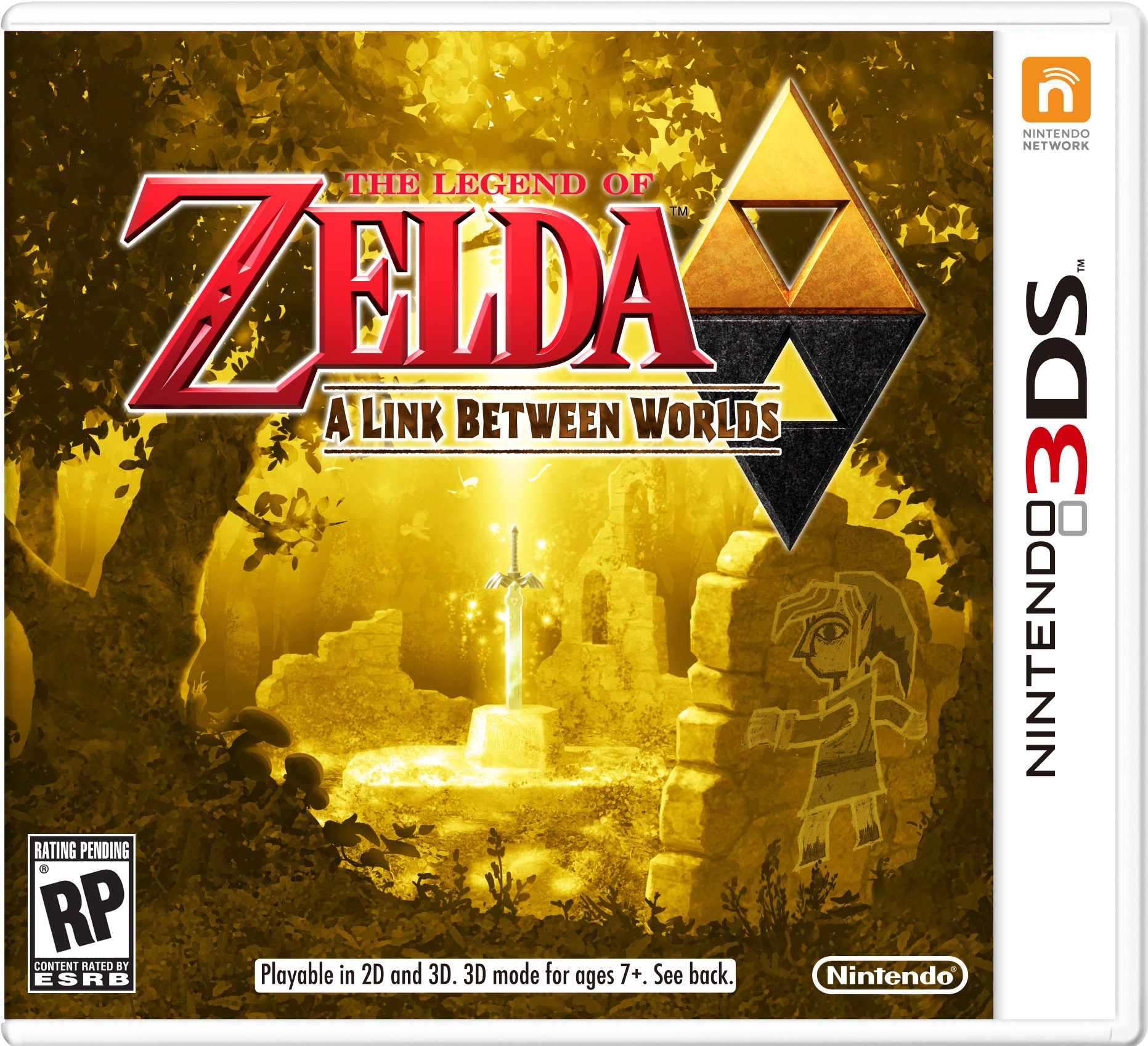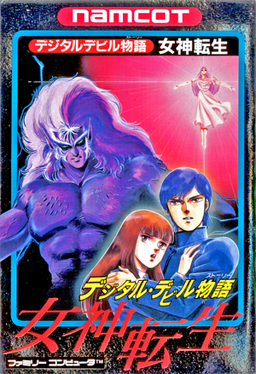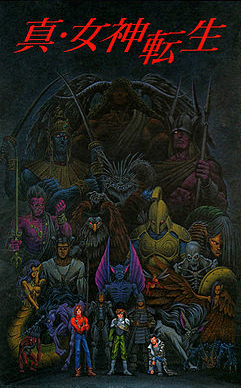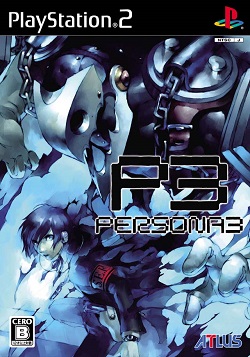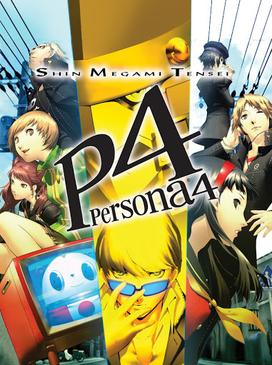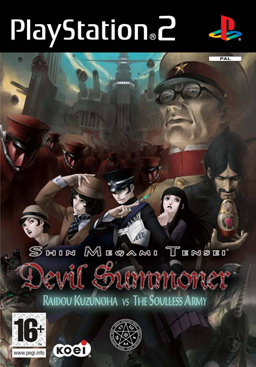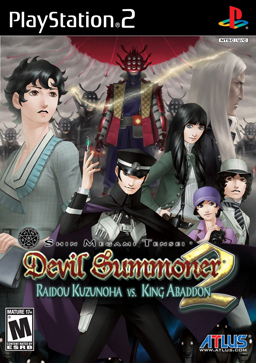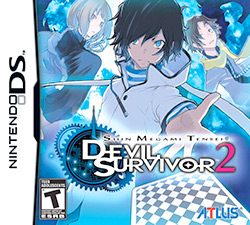With the
recent announcement that Persona 5 is
in development and is scheduled for a Japanese release in the winter of 2014,
exclusively for the PS3, I thought it was a good time to look back at a
storied franchise and examine the evolutionary chain that made the series what
it is today. In the 25 years that the series has been around, few of its
contemporaries have seen such innovation and adaptation. Shin Megami Tensei has earned a name for itself as a typically
traditional series that enjoys taking risks, and more often than not, enjoys
reaping the success of those risks.
In an age when the word “mature” has become
corrupted by the negative undertones of sex and violence, Shin Megami Tensei shows what it truly means to tell a mature tale,
tackling themes of spirituality, existentialism, corruption of the church and
government, youth, sexuality, self-worth, and more. It is a series that begs
its players to challenge it, to ask questions, but more importantly, to think
for yourself.
Megami Tensei Series
Though developed
by Atlus from the very beginning, the first two games under the Megami
Tensei moniker were published by Namco. Released in the early fall of 1997,
Digital Devil Story: Megami Tensei was a first-person RPG inspired by a
series of horror novels from acclaimed Japanese author Aya Nishitani
Digital
Devil Story: Megami Tensei
Original release
date:
September 11,
1987 (Japan)
This game
would feature what would become trademarks of the franchise and its spin-offs:
vast demonic mythology, extensive dungeon crawling, particular focus on
Japanese ideology, history, and the occult, and various gameplay mechanics that
were unprecedented at the time. Players were given the ability to interact with
the many demons they encountered, and through a process of negotiation, recruit
them into your party. Players were also granted the ability to fuse demons together
to create more powerful beings. Both elements of gameplay have survived the
franchise to this day, and though not all of them have appeared in every
external iteration, they still remain a primary focus of the series-proper.
Digital
Devil Story: Megami Tensei II
Original release date: April 6, 1990 (Japan)
The follow-up
to Atlus’s first title took the series to a place that would become a popular
setting for some of their most successful games much later in the franchise:
the post-apocalyptic world. Another innovation for the series, this was the
first game to introduce the world map to the Megami Tensei universe.
Shin Megami Tensei series
Shin Megami Tensei
Original release
date:
October 30,
1992 (Japan)
Atlus
returned to the helm of the first installment in what would become the primary
series in the Megami Tensei universe.
The game was notable for adopting a morality system seen most often in Western
RPGs, and popularized by the Dungeons and Dragons series of pen-and-paper RPGs.
The player’s actions, through dialogue or in some combat scenarios, tipped an
alignment scale toward either Law or Chaos. Players could also choose a more
Neutral route. This determined the outcome of the game and added the notion of
replay value into the series.
Shin Megami Tensei II
Original release
date:
March 18,
1994
Perhaps one
of the most important features of the demon fusion, introduced in the very
first game, was adapted here: the concept of “magic succession.” That is, the
ability to pass down the spells and abilities of demons that you are fusing
together. Among the other minor changes was the ability to select which spells
your demons can use in combat, giving you greater control on the battlefield.
The story picks up 50 years following Shin
Megami Tensei, under the continuity of the Neutral ending.
Shin Megami Tensei if…
Original
release date:
October 28,
1994
This was
developed as a companion story to the original Shin Megami Tensei, and as the title suggests, proposes a “what if”
situation had the outcome been different. The game did not propel the series
forward in any meaningful way, adding elements that were later dropped for all
subsequent releases, such as the Guardian Spirits. These acted as a type of
random effect: should the main character die, you would gain a Guardian Spirit, and
the next time you level, this would either boost or decrease a random stat,
determined by the type of enemy you were facing when you died.
Shin Megami Tensei: Nocturne
Original
release dates:
February 20,
2003 (Japan)
October 12,
2004 (North America)
July 1, 2005 (Europe)
Touted as
being one of the most difficult games of the PlayStation 2 era, and certainly
of the franchise as a whole, Nocturne
was also recognized as the first of the series to see a release in Europe. This
introduced the Press Turn battle system, a feature that would become a staple
of the series from here on out. In battle, you were given an amount of turns
equal to the number of members in your party (yourself, and up to 3 demons, for
a total of 4 turns). Performing certain actions such as exploiting enemy
weaknesses, scoring a critical hit, or reflecting/nullifying enemy attacks,
granted you an extra turn for each character that received it; similarly, you
could also lose a turn if the enemy did the same. This added an extra element
of strategy to battles and often gave way to some very strenuous bosses. Nocturne also introduced the Demonic
Compendium, another feature that would be of continued use throughout the series.
This allowed players to register their demons in a catalogue, either after
fusing or negotiating with them, giving you the option to summon them back for
a price should you need them again.

Shin Megami Tensei: Strange Journey
Original
release dates:
October 8,
2009 (Japan)
March 23,
2010 (North America)
Originally
intended to be released as the fourth “official” game of the main series, Strange Journey ended up as simply
another side story. Tackling themes of global warming and atomic threat, Strange Journey was one of the more
timely games of the series, set at the onset of the 21st century. Strange Journey also brought the series
back to its roots, dropping the camera angle into first-person during exploration,
which had been done away with for all subsequent games following Nocturne.
Shin Megami Tensei IV
May 23, 2013
(Japan)
July 16, 2013
(North America)
The most
recent game in the series as a whole, it did not offer much in the way of
innovation to a – by this time - proven formula, but it was the first in the main
series to feature a full cast of voice acting.
Persona
series
Revelations: Persona
Original
release dates:
September 20,
1996 (Japan)
October 25,
1997 (North America)
The Persona series marks a significant turn
for the franchise: it was the first to be published in the states, but more
importantly it adopted a new approach to combat. Rather than simply allying
with demons, your party consisted of ordinary teenagers – often high-school
students – that called upon their inner “personas” – facets of their individual
personalities – to fight for them. Persona
also added a lunar cycle, which not only indicated the passage of time, but
also represented certain enemy patterns, including behavior and mood, should
the players wish to negotiate.
Persona 2: Innocent Sin and Persona 2: Eternal Punishment
Original
release dates:
Innocent Sin
June 24, 1999
(Japan)
September 20,
2011 (North America) (PSP remake)
Eternal Punishment
June 29, 2000
(Japan)
December 22,
2000 (North America)
A direct
sequel to the first, Innocent Sin and
Eternal Punishment were two sides of
the same coin. The games introduced the new Fusion Spell system, which allowed
Personas from multiple characters to chain together spells. Additionally,
rumors played a significant role not only in the story, but in many gameplay
elements as well. The spread of certain rumors could affect the cost of weapons
or items in shops, and more, to varying degrees of success.
Shin Megami Tensei: Persona 3
Original
release dates:
July 13, 2006
(Japan)
August 14,
2007 (North America)
February 29,
2008 (Europe)
March 6, 2008
(Australia)
This was the
one. While Atlus had found mild success with their previous titles, it wasn’t
until Persona 3 that they solidified
themselves as a premier developer in the JRPG market outside of Japan. In it,
players took on the role of the unnamed protagonist and his new classmates as
they discover the secrets behind the Dark Hour, a mysterious hidden hour that
exists between midnight and 1 AM. Persona
3 added a significant feature that would carry over into the next game, and
one that deftly broadened the game’s appeal beyond that of typical RPGs. The
Social Links, as they were called, allowed you to establish bonds and build
friendships with various supporting characters in the game. In this sense the
game took on a bit of a simulation aspect. Because the game continued the lunar
cycle introduced in its predecessor, days were very limited. Performing certain
actions initiated the passage of time, which means if you chose to expand your
Social Links, you had little time for combat, and vice versa.
The benefit
of doing this, however, is that every Social Link was attributed to different Arcana
of popular tarot card decks: The Lovers, The Hermit, The Empress, etc. These Arcana
were subsequently linked to the various demons, or persona, your character
could call upon, and were affected directly by the strength of those Social
Links. Build your relationships, and you increase your prowess in combat, thus
adding a more immediate sense of urgency to your daily actions: do you head
into the dungeons to fight and gain experience, or do you build your social
links and strengthen your demons? Finding the right balance was one of the
game’s strongest aspects and one that carried over into the sequel. A year
later, Persona: FES was released,
which was an enhanced version of the original and contained a special epilogue
chapter known as “The Answer.”
Shin Megami Tensei: Persona 4
Original
release dates:
July 10, 2008
(Japan)
December 9, 2008
(North America)
March 13,
2009 (Europe)
March 12,
2009 (Australia)
Without too
many improvements to its predecessor, Persona
4 simply refined a formula that made the previous installment so
successful. Featuring a whole new cast of characters, the game took place
largely parallel to Persona 3. The
game followed another band of high school students as they attempted to solve a
murder and the mystery of the Midnight Channel, a special TV program that if
watched, reveals your soulmate. Shortly thereafter, the person disappears. The
game had an overall Scooby Doo Gang vibe, which helped keep its cast likable
and relatable without bringing the story down. An enhanced edition was later
made for the PlayStation Vita, called
Persona 4 Golden, and later a fighting simulator featuring a crossover cast
from Persona 3, called Persona 4 Arena.
Devil Summoner
series
Shin Megami Tensei: Devil Summoner
Original
release date:
December 26,
1995 (Japan)
The first
game in the franchise developed for a 32-bit platform, Devil Summoner was also notable for abandoning the post-apocalyptic
world.
Shin Megami Tensei: Devil Summoner:
Soul Hackers
Original
release dates:
November 13,
1997 (Japan)
April 16,
2013 (North America) (Nintendo 3DS remake)
September 13,
2013 (Europe) (Nintendo 3DS remake)
Soul Hackers, which has been the most recent
enhanced remake, offers a unique futuristic spin on the typically contemporary
series. Players controlled the COMP, a device that aids not only with demon
fusion, but also with various other gameplay mechanics such as scanning enemy
demons, any-time demon negotiations, and map enhancements.
Shin Megami Tensei: Devil Summoner:
Raidou Kuzunoha vs. the Soulless Army
Original
release dates:
March 2, 2006
(Japan)
October 10,
2006 (North America)
April 27,
2007 (Europe)
May 3, 2007
(Australia)
Not only is
this one of the longest titles in the series, but it is also the polar opposite
of its predecessor: taking place in the early 20th century, Raidou Kuzunoha is an action game
similar to Namco’s Tales of series.
Featuring the franchise’s persistent demon fusion, combat takes place in an
isolated “arena” where the player can move in a three-dimensional space and
attack in real time. Besides the normal fusions, you can also fuse demons into
Raidou’s sword, enhancing its properties. Raidou himself is a high school
student from a legendary demon summoning family-turned-detectives.
Shin Megami Tensei: Devil Summoner 2:
Raidou Kuzunoha vs. King Abaddon
Original
release dates:
October 23,
2008 (Japan)
May 12, 2009
(North America)
No new
additional elements were added in this direct sequel; rather, mechanics and
features of its predecessor were simply refined. The game continues the story
of Raidou set shortly after the events of the first.
Digital Devil Saga series
Shin Megami Tensei: Digital Devil Saga
1 and 2
Original
release dates:
Digital Devil Saga 1
July 15, 2004
(Japan)
March 29,
2005 (North America)
July 21, 2006
(Europe)
Digital Devil Saga 2
January 27,
2005 (Japan)
October 11,
2005 (North America)
March 2, 2007 (Europe)
Digital Devil Saga introduced a strange and foreign
world known as the Junkyard, a vast, post-apocalyptic wasteland besieged by
constant rainfall. The games were heavily influenced by Hinduism: both
thematically and categorically. Rather than summoning demons or fighting
alongside them, the main characters had the ability to transform into specific
demons. Demon Fusion was removed for these games, and replaced by a large,
encompassing sphere grid of stats and spells. Unlike other games, you could
switch your abilities at any time, and did not lose older spells when leveling
up, adding a greater level of customization for each character.
Devil Survivor
series
Shin Megami Tensei: Devil Survivor
Original
release dates:
January 15,
2009 (Japan)
June 23, 2009
(North America)
March 29,
2013 (Europe)
The Devil Survivor games took the series
into the land of strategy RPG, adding a minor grid-based element outside of
direct combat. Characters were placed on squares in the environment and then
allowed to move a set distance each turn. Certain actions could be performed
out in the world, such as healing or primitive forms of attack. Making contact
with an enemy initiated a battle typical to others in the series. Set in a
fictionalized version of present-day Tokyo, the main character and his two
friends discover that they have been given strange electronic devices called
COMPs. As they seek to understand their new gifts, the city is sieged by an
onslaught of demons and a quarantine is placed into effect. They have seven
days to figure out the source of the outbreak or witness the destruction of
mankind. A demon auction was added, allowing players to bid on specially-fused
demons against AI counter-bidders.
Shin Megami Tensei: Devil Survivor 2
Original
release dates:
July 28, 2011
(Japan)
February 28,
2012 (North America)
Taking the
setting outside of Tokyo and covering the whole expanse of Japan, Devil Survivor 2 follows a similar set
of high school students, this time dealing with matters a bit closer to home. A
strange website known as Nicaea begins sending e-mails to people with a video
embedded, forewarning recipients of their death. If you receive one, you have
the chance to prevent it. The combat system is largely identical to its
predecessor, with returning elements such as demon fusion and bidding.
True Goddess Reincarnation
Though the
franchise exists in the form of countless other media (including mobile games,
movies, manga, and even several attempts at online games), it has endured and
proven itself to be a formidable contemporary to the likes of Final Fantasy and Dragon Quest. Atlus is a respected developer and publisher of the
acute, and though they may never compete on a financial level with SquareEnix,
tri-Ace, Namco, or any other big name in the Japanese Role-Playing scene, they
may very well outweigh them with sheer ingenuity and depth of gameplay.
